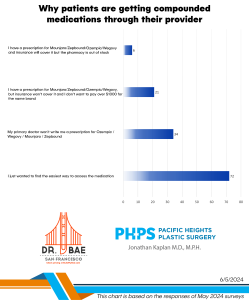
1. They cause cancer
Breast implants don’t cause the typical type of breast cancer that the vast majority of women have. A very rare form of cancer known as lymphoma, which is more of an overgrowth of lymphatic tissue like lymph nodes that can occur anywhere in the body, can also appear, under certain circumstances, around a breast implant.
Specifically, implants with a textured surface, as seen in shaped or tear drop implants, may result in a very small risk of anaplastic large cell lymphoma (ALCL). This arises in the scar tissue that naturally forms around all breast implants. And within that subset of patients with textured implants, there are patients that have a certain brand of implants (Allergan), that may get ALCL. It can been seen in other brands of textured implants but they’re most commonly seen in that brand.
A patient may notice months or even years after surgery that they suddenly get a fluid collection around their implants. That fluid can be sent to a pathology lab that can diagnose ALCL because of specific proteins found in the fluid. The treatment is to go in and remove the scar tissue around the implant and the implant itself and this usually leads to a cure. So while breast implants can cause a type of cancer, it’s not “breast cancer.”
2. You have to change them out every 10 years
Simply not true.
There are multiple studies that review implants over the course of 10 years and find that a follow up surgery is necessary in about 20% of patients at 10 years. But that means 80% of patients are fine. So if you’re not having any issues with your breast implants, you don’t have to change them out after 10 years, or maybe ever.
3. You have to get shaped/teardrop for them to look natural
Here’s a little secret. Yes, teardrop or shaped implants have less fullness at the top portion of the breast to make them look more natural. But if you don’t get huge implants (round or shaped), they’ll look natural either way!
Go big or go home isn’t true when it comes to breast implants!
4. You can’t breast feed afterwards
Not every woman can breast feed but this has nothing to do with breast implants. So if you’re theoretically or actually able to breast feed before breast implants, you’ll be able to breast feed after breast implants.
5. The silicone can leak into the body
It’s important to make the distinction between older and new implants on this point. Older generation implants that ruptured have been shown to leak silicone molecules to the armpit region and even the liver. But newer implants, as discussed in this document submitted to the FDA, don’t leak into the body. They may leak out of the implant’s silicone shell but they stay contained within the scar tissue around the implant.
To reiterate, scar tissue naturally forms around any foreign object in the body – knee replacements, pacemakers and even breast implants. And this means all breast implants – saline or silicone. So when an implant ruptures and the silicone gel leaks out of the implant, the document above reports that none of that silicone leaked out of the scar tissue surrounding the implant.
Video: The 5 myths about breast augmentation debunked!
Click here to check pricing on breast augmentation from Dr. Kaplan (aka Dr. Bae)!
Click here for the original blog post written by Dr. Kaplan for BuildMyBod.




